| SUMMARY |
| Large areas of tree crops are found in the tropics, some portion of which can be integrated with pastures and cattle. With almost 11 million hectares the coconut palm (Cocos nucifera) is the tree crop most suited to integration, with its wide spacing, peculiar morphological features and root system and high incidence of solar radiation reaching the ground surface. Over 90 percent of the coconut area is located in Asia and the Pacific Region where millions of farm families depend on coconut for their livelihood. |
| As well as advantages (such as increased yields, increased and diversified income, reduced weeding costs and better utilization of labour) there are also disadvantages to intercropping (such as competition for water and nutrients, reduction in yield of the main crop, an increase in pests and diseases and possible difficulties in carrying out management operations on the main crop). |
While a number of major agricultural systems have been identified in the humid tropics with which cattle are associated (see Beets, 1990; FAO, 1984a; McDowell and Hildebrand, 1980; Ruthenberg, 1980; Spedding, 1975) this book is concerned only with the perennial crop cultivation (see Table 1), plantation or tree crop farming system (see Figure 1), and particularly with the coconut (Cocos nucifera) and with the integration of pastures, forages and cattle.
Table 1. - Main systems of tropical agriculture (Payne, 1976)
| System | Number of bovines (millions) | Type of bovine |
| Migratory shifting cultivation | 6 | cattle |
| Sedentary shifting cultivation | 30 | cattle and buffaloes |
| Sedentary subsistence cultivation | 290 | cattle and buffaloes |
| Regulated ley farming | 15 | cattle |
| Perennial crop cultivation | 15 | cattle and buffaloes |
| Nomadic herding | 32 | cattle |
| Transhumance | 63 | cattle |
| Commercial ranching | 180 | cattle |
There are now probably more than 22 million1 bovines (cattle and buffalo) associated with the perennial crop cultivation system in the tropics. Although this represents only about 2 percent of all tropical bovines, it has been estimated that if only half of the tree crop area could be integrated, the livestock population of the humid tropics could be increased 25 percent without utilizing any new land (Payne, 1976). Nair (1983), estimated that perennial tropical plantation crops occupy about 8 percent of the total arable land found in developing countries. Payne (1985) estimated that the area of coconuts in the humid tropics suitable for cattle/coconut operations could be of the order of 6.0 million hectares, although probably only one sixth to one quarter is presently being so used. According to Abdullah et al. (1992) in Malaysia alone there are more than 3.5 million hectares of land under rubber, oil palm and coconuts where production of native and sown pasture species in the interrows between trees is sufficient to support animal production.
1 Based on an annual growth rate of approximately 2.0 percent (Devendra, 1995).
Many of the ideas and principles discussed are applicable to other tree crops such as oil palm (Elaeis quineensis), rubber (Hevea brasiliensis), clove (Eugenia aromatica), cashew (Anacardium occidentale), guava (Psidium Guajava), kola (Cola nitida), kapok (Ceiba petandra), mango (Mangifera indica), various other fruit trees (Humphreys, 1978) and in tropical reafforestation projects with species such as Araucaria cunninghamii, Eucalyptus deglupta, E. grandis, Pinus caribaea, P. kesiya, Swiethenia macrophylla, and Toona ciliata (Gregor, 1972; Pottier, 1984; Ryan and Lewty, 1984; Whiteman, 1980). Indeed in some cases systems have been established already and also research work is in progress to study the integration of cattle, sheep, goats, poultry, ducks, pigs and also bees with various perennial tree crops (Alpizar, 1987; Amyot, 1988; Anderson and Dowling, 1987; Anderson et al., 1988; Andrews and Kwaengsopha, 1978; Arope et al., 1985a; 1985b; Asiedu, 1978; Asiedu et al., 1978; Asiedu and Karikari, 1985; Azizan et al., 1990; Bazill, 1987; Berges et al., 1993; Bishop, 1983; Bradford, 1990; Branckaert and Mbayahaga, 1993; Briscoe, 1983; Budowski, 1983; 1987; Cameron et al., 1989; Chen, 1984; 1989; 1991; 1993; Chen and Bong, 1983; Chen et al., 1978; 1991; Chen and Khairuddin, 1993; Chen and Othman, 1984; Chen and Samsudin, 1991; Cheva-Isarakul, 1990; 1991; Chong et al., 1991; Combe, 1982; Cook, 1984; Dahlan et al., 1988; 1990a; 1990b; 1990c; 1991; Dereinda et al., 1991; Devendra, 1978; Evans, 1992; FAO, 1983d; 1983e; Gaullier, 1986; Gill and Gangwar, 1990; Goldson, 1973; Haridasan et al., 1988; Hassan et al., 1992; Herve, 1991; Humphreys, 1978; 1991; Hutagalung, 1981; Iniguez and Sanchez, 1991; Ishak Jaafar, 1978; Johari et al., 1991; Khairuddin and Chen, 1992; Khumnirdpetch, 1980; Kirby, 1976; Lee et al., 1978; Lewis and Pearson, 1987; Lewis et al., 1984; MacFarlane and Whiteman, 1980; Mack, 1991; Majid et al., 1989; Manidool, 1985; Martojo, 1978; McDowell and Hildebrand, 1980; Mohd. Jaafar Daud and Mohd. Khusahry Mohd. Yusuff, 1983; Mohd. Mahyuddin et al., 1978; Mohd. Najib, 1990; Mohd. Najib, 1991; Mohamed Ngah et al., 1991; Mohamed et al., 1987; Moog, 1993; Moore, 1991; 1993; Mukherjee, 1988; Mukherjee et al., 1978; Nambiar, 1991; Nitis et al., 1991a; Parawan, 1991; Payne, 1985; Pearson et al., 1990; Penaloza et al., 1985; Pillai and Seeveneserajah, 1988; Pillai et al., 1985; Pottier, 1984; Preston, 1992; Reid and Wilson, 1986; Repollo, 1985; Rika, 1991; Robinson, 1983; Rombaut, 1974; Ryan and Lewty, 1984; Samuel, 1974; Sanchez, 1990; Sanchez and Pond, 1991; Somarriba, 1988a; 1988b; Shelton and Stur, 1991; Shelton et al., 1987a; 1987b; Sibon, 1991; Simonnet, 1990; Sophanodora and Tudsri, 1991; Stur and Shelton, 1991; Tajuddin, 1986; Tajuddin and Chong, 1988; 1991; Tajuddin et al., 1990; 1993; Thomas, 1978; 1990; Thomas and Bradford, 1991; Thongmee, 1993; Tustin et al., 1979; Vanselow, 1982; Vijchulata, 1991; Wahab, 1994; Waidyanatha et al., 1984; Wan Embong and Abraham, 1976; Wan Mohamed, 1978; 1982; Wan Mohamed et al., 1987; 1988; Watanayothin and Klodpeng, 1990; Watson, 1983; Wilson, 1991, 1994; Wong et al., 1985a; 1985b; Wood, 1990).
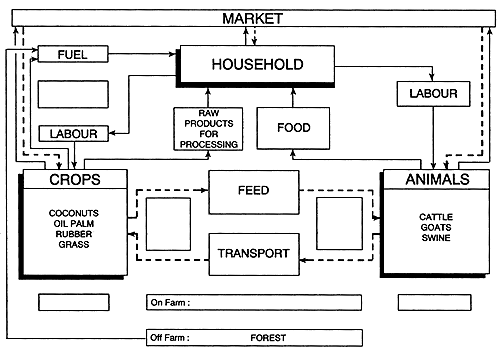
Figure 1. - Tree-crop farming in Asia, long-term cropping, low to moderate integration of crops and animals (animals tethered or roving). (Source FAO, 1984a from McDowell and Hildebrand, 1980).
There are probably between 10 and 11 million hectares of coconuts (Cocos nucifera) in the world (and recently Persley, 1992, suggested a figure of 11.6 million hectares), with more than 90 percent located in Asia and the Pacific region (see Table 2). This area has probably more than 1220 million palms, with over 400 million reported in the Philippines alone (Anon., 1982a; Barile and Sangalang, 1990; Moog and Faylon, 1990; Pordesimo and Noble, 1990). Punchihewa (1991) indicates that coconut is found in nearly 90 countries ranging from an annual production of 12 billion nuts in the Philippines to 2.5 million nuts in Nauru. According to Opio (1990a) the area under coconuts represents about 20 percent of the cultivated land in most coconut producing countries, producing around 50 billion nuts (Anon., 1991a) or nearly 9 million metric tons of copra equivalent per year (Anon., 1990a). The major producers of copra and coconut oil are listed below. Some idea of the role of coconut in the Philippine economy (the No. 1 supplier of coconut products - Magat, 1992) can be seen in the following figures: export earnings from coconut by-products in 1988 were about 32 percent of the total value of agricultural exports or 8.1 percent of the total value of Philippine exports; coconut provided a livelihood for 1.5 million farmers in 1984; coconuts occupy 30 percent of the total agricultural area of the country and of the more than 3.0 million hectares in excess of one third is intercropped (Guzman, 1990) and some 2 million hectares are suitable for intercropping. The country supplies about 52 percent of the total global supply of exported copra and oil (Aguilar and Benard, 1991). Lampa (1979) indicated that approximately 14 million Filipinos directly depend on coconut for their livelihood while Magat (1992) put the figure at 18 million and Persley (1992) suggests about one-third of the population. Ontolan (1988) suggested that, directly or indirectly, the coconut industry supports approximately one third of the national population. Coconuts are grown throughout the Indonesian archipelago and according to Sondakh and Kaligis (1991) approximately 10 million people obtain their livelihood from about 200 million palm trees on 3 million ha of coconut farms. In India there are approximately 5 million farm families growing coconuts, with a further 10 million people dependent, directly or indirectly, on coconut for their livelihood through processing and sale of the crop (APCC, 1986). According to Opio (1990a), in the Pacific over 80 percent of farm households are engaged in coconut cultivation. Persley (1992) indicates that worldwide there are estimated to be more than 10 million farm families (approximately 50 million people) directly involved in coconut cultivation, with a further 30 million people in Asia alone dependent directly on coconut and its processing for their livelihood.
Table 2. - Estimated area of coconut palms (in million hectares)
| A1 | B2 | C3 | ||
| Philippines | 3.36 | 3.30 | 3.11 | |
| Indonesia | 3.18 | 3.15 | 3.33 | |
| India | 1.23 | 1.23 | 1.51 | |
| Sri Lanka | 0.42 | 0.42 | 0.42 | |
| Malaysia | 0.29 | 0.30 | 0.32 | |
| Thailand | 0.42 | 0.42 | 0.40 | |
| Oceania | 0.79 | 0.50 | 0.34 | |
| Papua New Guinea | 0.24 | 0.25 | 0.26 | |
| Africa | 0.38 | 0.38 | 0.45 | |
| Mexico | } | 0.46 | 0.14 | 0.14 |
| West Indies | } | 0.07 | 0.06 | |
| Vietnam | } | 0.33 | 0.33 | |
| Central and S. America | } | 0.03 | 0.03 | |
| Other Asian Countries | 0.24 | 0.06 | 0.07 | |
| Total | 11.01 | 10.58 | 10.77 | |
1 Thampan (1989)
2 1991 estimate by author based on information from various sources
3 Taufikkurahman (1991)
Figures shown in Table 2 compare with estimates made by Child (1974) of 4.18 million ha, Payne (1974) of 4.43 million ha, Thampan (1975) of 6.81 million ha, Plucknett (1979) of 6.87 million ha, FAO (1979a) of 7.2 million ha, Reynolds (1988) of 8.91 million ha, Friend (1990) of 11.0 million ha, Punchihewa (1991) of 10.0 million ha, Persley (1992) of 11.6 million had and Taufikkurahman (1994) of 10.9 million ha.
The ideal mean annual temperature for coconut growing is usually considered to be in the region of 29°C (27–32°C), with abundant sunshine and a well distributed annual rainfall between 1250 and 2250 mm (Cornelius, 1973; Purseglove, 1972). In Vanuatu Berges et al. (1993) stress that rainfall should be around 130 mm per month with a dry period (<50 mm per month) not exceeding three consecutive months. Persley (1992) suggests that for optimum production, coconut requires an average temperature of 29°C, with a diurnal fluctuation not exceeding 7°C, and an annual rainfall of at least 1,800 mm, evenly distributed throughout the year. Although the distribution of the coconut palm extends outside the tropics in places as far north as 26° N and south to 27° S, the major areas of production lie between latitudes 20° N and 20° S, and below the 300 m contour. The distribution is shown in Figure 2.
Four main characteristics determine the suitability of the tall coconut var. typica (a tall unbranched tree, with a terminal crown of leaves, growing to a height of 20–30 m, with a life span of 80–100 years (Purseglove, 1972)) for intercropping (see Figures 3 and 4):
The planting distance (generally in the range 7 m × 7 m to 10 m × 10 m for tall cultivars, with an average planting density of around 130–180 palms ha-1, and as close as 5.5 m × 5.5 m for dwarf palms giving planting densities as high as 400 palms ha-1 (Friend, 1990), depending on whether rectangular, square or triangular planting systems are used - see Figure 4). In coconut monoculture as little as 25 percent of the land may be effectively used (Darwis and Tarigans, 1990; Magat, 1990; Ontolan, 1988). According to Magat (1990) whereas the potential (maximum) annual biological productivity of a cropping system under optimum conditions (Loomis and Williams, 1973) is of the order of 280.5 t ha-1 of dry matter (770 kg ha-1 day-1), for coconuts even at high nut yields of 100 nuts tree-1 and 200 nuts tree-1 the annual productivity is only 18.70 t ha-1 and 35.5 t ha-1 of dry matter (or 6.6 and 12.6 percent respectively of the potential biological activity). Clearly coconut monocropping has a very low utilization efficiency of agricultural land and even with varietal improvement is likely to remain so.
The morphological features of the coconut which mean that coconut palms may occupy less than 30–40 percent of the available air space between canopy and ground during the major part of their life span (Bavappa, 1975).
The nature of the canopy of fronds and the proportion of incoming solar radiation which reaches the ground. According to Liyanage (1985), Liyanage and Martin (1987) and Nair and Balakrishnan (1976), on average some fifty six percent of solar radiation is available for intercrops, although this will vary with age of the coconut stand and planting density.
The depth of the roots which are mostly in the 30–120 cm soil layer in a 2 m radius around the palm (Henry Louis, 1989; Liyanage, 1985; Nair et al., 1974) thus leaving some seventy to seventy five percent (Kushwah et al., 1973; Ontolan, 1988) of the soil unutilized or underutilized (see Figure 5). In Bali, Steel and Humphreys (1974) showed that palm roots were still very dense 3 m from the trunks and that some laterals occurred. More recently, Anilkumar and Wahid (1988) used P isotopes to determine the root activity pattern of 9 year old coconut palms. Over 80 percent of active roots were found to be confined to an area of 2 m radius around the palm and to the 25 to 60 cm soil layer (see Figure 6). In Brazil, Cintra et al. (1992), investigating the root systems of dwarf coconut varieties, found that for six year old trees the largest quantity of roots occurred in the 0.2–0.6 m horizon and 90% of total roots and 85% of fine roots within a radius of 1.5 m around the stem. Studies of the type carried out by Eastham and Rose (1990) using Eucalyptus grandis and Setaria sphacelata cv Kazungula on the effects of tree density on the distribution of tree and pasture roots might be appropriate where coconuts are integrated with pastures.
Figure 2. - Coconut producing areas of the world (after Plucknett, 1979).
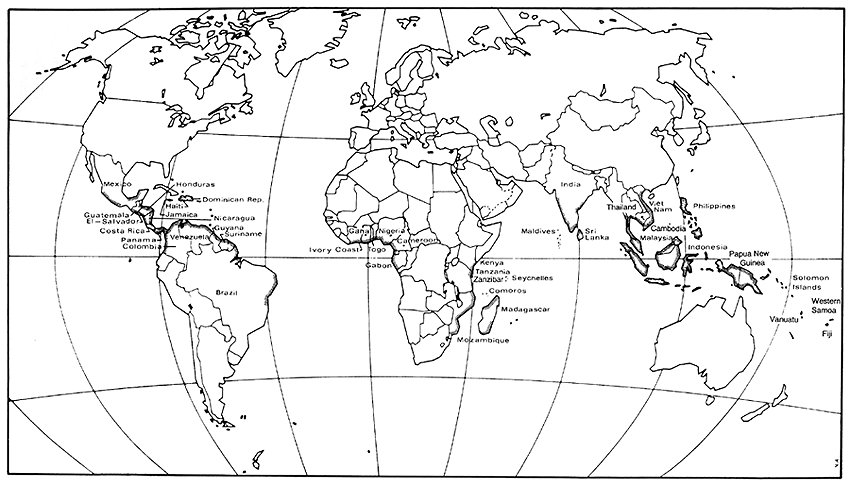
The introduction of dwarf varieties and the closer spacing of hybrids and tall varieties (Barrant, 1975; Smith, 1972) may reduce possibilities for intercropping, but at present most of the world area of coconut palms is of the tall varieties at wide spacings and in future plantings the choice of spacing may be influenced by the decision to intercrop (Etherington and Karunanayake, 1981; Whitehead and Smith, 1968).
Thus by the very nature of the coconut tree there is a large area of land beneath the tree canopy which the farmer has to decide how to utilize. If he does nothing then weeds will grow beneath the palms. He may choose to try to keep the weeds at bay by a variety of means or he may decide to establish intercrops. Payne (1976) suggested that the weeds be replaced by forage species whose growth could be controlled by grazing animals.
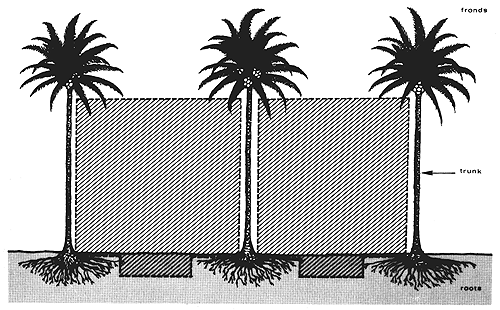
Figure 3. - Schematic representation of available intercropping area in coconut stands.

Figure 4. - The three common planting systems or arrangements-square, rectangular and triangular (Magat, 1990).

Figure 5a. - Schematic representation of horizontal root distribution of a multiple intercropping system with coconut (Nelliat et al., 1974).
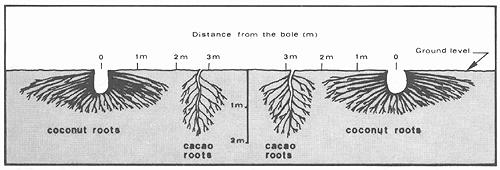
Figure 5b. - Schematic representation of vertical root distribution of cacao intercropped with coconut (Nelliat et at. 1974).

Figure 6. - Root activity pattern of coconut palm in relation to lateral distance from the tree and soil depth (Anilkumar and Wahid, 1988).
Production systems range from the raising of coconuts in monoculture to single and multiple intercropping systems (see Figures 5 and 8) for subsistence, subsistence and cash, to the large commercial estates and plantations. Sondakh and Kaligis (1991) refer to a study of nearly 200 coconut farms in North Sulawesi which showed an inverse relationship between size of coconut area and the proportion of area intercropped (which fell from 70 percent on coconut farms in the range 0.50–1.35 ha to 25 percent on farms larger than 4.01 ha; with a mean of 35 percent on all farms in the range 0.50–8.00 ha). Small farmers tend to develop quite complex systems of intercropping with three or four (or more) crops (Figure 8), while on larger plantations there may only be one or possibly two intercrops such as cocoa (Figure 9) or coffee. Among the intercrops are various food crops such as pulses, root crops and vegetables (Cuevas et al., 1974; Karunanayake, 1990a; Nair, 1993; Nelliat and Krishna, 1976; Opio, 1990b; Sahasranaman and Sethumadhava Menon, 1973), other tree crops like cacao (Bavappa, 1990a; Jamadon and Osman, 1990; Leach, 1971; Nair, 1993; Ovasuru, 1988; Yusof and Rejab, 1988), coffee (Ovasuru, 1988), citrus and cloves (Darwis, 1990; Karunanayake, 1990c; Klodpeng, 1990), fruits like papaya and banana (Darwis, 1988; Magat, 1990; Nair, 1993; Ohler, 1984, Smith, 1968), to crops such as passion fruit (Anon, 1991b), pineapple (Das, 1990), pepper (Bavappa, 1990b) and pastures, both natural and improved (Bavappa, 1990b; Jayawardana, 1988; Klodpeng, 1990; Lavaka, 1988; Liyanage, 1990a; 1990c; Ontolan, 1988; Ovasuru, 1988; Rungrueng, 1988; Thomas, 1978; Yusof and Rejab, 1988).
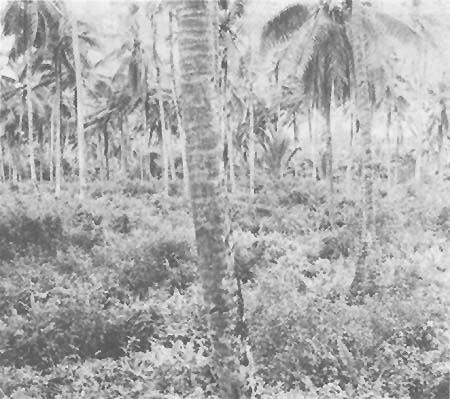
Figure 7. - A weed infested stand of coconut.
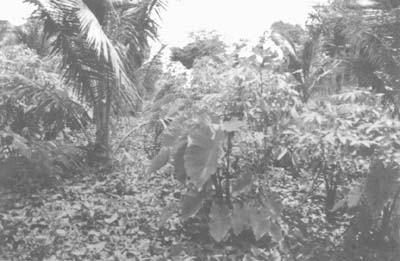
Figure 8. - Vanuatu: intercropping of young coconuts with cassava, sweet potato and taro.
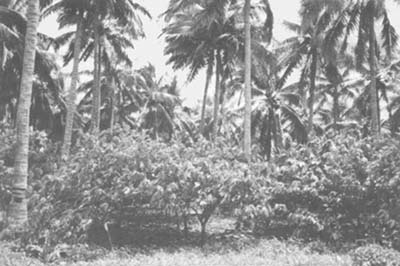
Figure 9. - Vanuatu: intercropping of cocoa and coconut.
Table 3 lists the various intercrops found in Sri Lanka (Liyanage et al., 1986). To these can be added kava or yaqona (Piper methysticum) on Pacific islands such as Fiji, Vanuatu (Paulo, 1990) and Western Samoa (Opio, 1987); watermelon and pumpkin (Tonga); cabbage, cauliflower and tomato (Malaysia); breadfruit and various fruit trees such as avocado, durian, mango and rambutan (Indonesia); vanilla and capulaga in Bali (Nitis et al., 1991); jute, kenaf and arrowroot (Philippines), and a range of other crops including mulberry (Dias, 1989), rice where coconuts are grown on bunds and sometimes fish and shrimps in the canals (Danh, 1990). Shade tolerance of various intercrops was reviewed by Ontolan (1988).
Coconut based farming systems have been described by Bavappa, 1990a; 1990b; 1990c; Bavappa et al., 1986; Dahn, 1990; Darwis, 1990; Das, 1990; Duriwarni et al., 1987; Guzman, 1990; Karunanayake, 1990a; 1990b; Klodpeng, 1990; Liyanage, 1983; 1990a; 1990b; Liyanage et al., 1984; 1986; 1989; Liyanage and Dissanayake, 1988; Magat, 1990; Mahmud and Akuba, 1989; Nair, 1993; Nair and Gopalasundaram, 1990; Ontolan, 1988; Opio, 1990a; 1990b; 1990c; Ranatunga et al., 1988; Rosario, 1990; Sahasranaman et al., 1983; Wilson, 1994 and a major bibliography has been compiled by de Silva, 1990. Recently, Dahlan et al. (1991) described the development of a model (the LICRO package) used in the planning of livestock-crop integrated production systems. Earlier Dahlan (1989) had formulated the OPCIS (Oil Palm-Cattle integration system) model.
While the intercropping of coconuts is a very old mixed farming system (Plucknett, 1979; Etherington and Karunanayake, 1981; Rosario, 1990), the economics of intercropping have only been examined closely in the last decade or so. Workers such as Nik Fuad and Shaaban (1983) have demonstrated that the relationship between the main crop and intercrops (and between intercrops) may be complimentary, supplementary or competitive (or positive, negative and independent - Anon, 1990b). In Sri Lanka, Ranatunga et al. (1988) found that in spite of research over two decades or more, various technical, economic and social constraints have led to relatively slow adoption of systematic intercropping practices in coconut areas even though as demonstrated by Karunanayake (1990c) and Liyanage and Dissanayake (1988) the returns are much higher (see Tables 4a and 4b). Similar yield and income data from Malaysia were presented by Yusof and Rejab (1988) quoting from Denamany et al. (1979). In the South Pacific Opio (1990b) has examined various intercropping enterprises producing estimated cash flows, returns to labour and benefit cost ratios (Table 5). Tondok (1991) demonstrated in Indonesia that an intercropping system with coconuts is more beneficial than a monoculture system, with land use intensity increasing by 28–117 percent. Espino et al. (1988) describe various intercrop combinations in the Philippines which provide additional income for coconut farmers. They suggest that it is not certain which crop combination is the most rewarding in different coconut areas of the Philippines; “this depends on social, environmental, and economic factors, as well as crop varieties”. Das (1990) demonstrated the much higher employment potential of coconut based multistored and mixed farming systems and (1991a) showed that it should be relatively more profitable to integrate a number of subsidiary crops and animal components with coconut rather than raising it as a monocrop. Mahmud and Abuka (1989) concluded that “intercrops had no bad effect on coconut production and in certain cases they tend to increase the production of coconut and give an additional income to farmers”.
Table 3. - Intercrops grown under coconuts in Sri Lanka (Liyanage et al., 1986)
| Type of crops | Crops | Wet zone | Intermediate wet zone | Intermediate dry zone | ||
| 1. | Food crops | |||||
| Tubers | Cassava | Manihot esculenta | x | x | ||
| Sweet Potato | Ipomea batatas | x | x | |||
| Taro | Colocasia spp. | x | x | |||
| Yams | Dioscorea spp. | x | x | |||
| Cereals | Finger millet | Eleusine coracana | x | |||
| Maize | Zea mays | x | ||||
| Sorghum | Sorghum bicolor | x | ||||
| Legumes | Cowpea | Vigna unguiculata | x | x | ||
| Green gram | Vigna radiata | x | x | |||
| Groundnut | Arachis hygopaea | x | x | |||
| Soybean | Glycine max | x | ||||
| Winged bean | Psophocarpus tegragonolus | x | x | |||
| Fruit crops | Banana | Musa spp. | x | x | x | |
| Citrus | Citrus spp. | x | x | |||
| Papaya | Carica papaya | x | ||||
| Passion Fruit | Passiflora edulis | x | x | |||
| Pineapple | Ananas comosus | x | x | |||
| Pomegranate | Punica granatum | |||||
| 2. | Spices and condiments | |||||
| Arecanut | Areca catechu | x | x | |||
| Betel leaves | Piper betel | x | x | |||
| Chillies | Capsicum spp. | x | x | x | ||
| Ginger | Zingiber officinale | x | x | |||
| Turmeric | Curcuma longa | x | x | |||
| 3. | Minor export (cash) crops | |||||
| Black pepper | Piper nigrum | x | x | |||
| Cacao | Theobroma cacao | x | x | |||
| Cinnamon | Cinamon zeylanicum | x | x | |||
| Clove | Syzygium aromaticum | x | x | |||
| Coffee | Coffea spp. | x | x | |||
| Nutmeg | Myristica fragrans | x | x | |||
| 4. | Others | Pasture grass | Brachiaria miliiformis | x | ||
| Sesame (oil seed) | Sesamum indicum | x | ||||
However, in spite of the potential for improvement, large areas of coconut are still underlain by land covered with unproductive weeds and bushes (see Figure 7). Ontolan (1988) gives various socio-economic constraints peculiar to coconut farms in the Philippines as reasons why farmers have not taken full advantage of the intercropping and intergrazing opportunities. These include: land tenure, off-farm employment, farm sizes, availability of labour, household cash position, implement availability, product prices, input costs, marketing costs and distribution channel preferences.
Table 4a. - Expenditure and Income from Coconut-Intercropping Systems in the Wet Zone (1982–1986)
| Systems | Total Expenditure per ha (Rs.) | Total Income per ha (Rs.) | Net Income invested (Rs.) | Net returns per Rupee |
| Coconut monoculture | 15,625 | 46,462 | 30,837 | 1.97 |
| Coconut/Cacao | 49,333 | 224,281 | 174,948 | 3.55 |
| Coconut/Coffee | 54,520 | 149,853 | 95,325 | 1.75 |
| Coconut/Pepper | 63,035 | 283,717 | 320,682 | 5.10 |
| Coconut/Clove + Banana | 33,923 | 86,795 | 52,872 | 1.56 |
| Coconut/Cinnamon | 32,829 | 117,729 | 84,900 | 2.60 |
Table 4b. - Coconut-Based Mixed Cropping Models in the Wet and Intermediate Wet Zone (1986)
| Model | Yield | Income (Rs.) |
| Coconut/Coffee/Cacao/Pepper (0.4 ha) | 2184 nuts/14 kg/48.3 kg/168.5 kg | 23539.60 |
| Coconut/Cacao/Pepper (0.4 ha) | 2995 nuts/59 kg/146.3 kg | 22033.50 |
| Coconut/Clove/Banana (0.35 ha) | 3364 nuts/60 kg/480 kg | 19947.60 |
| Coconut monoculture (0.4 ha) | 1920 nuts | 1728.00 |
Source: Liyanage and Dassanayake (1988) Coconut Research Institute, Lunuwila; Sri Lanka.
Table 5. - Benefit-Cost Analysis for Coconut Local Talls (LT) and Intercrops in Western Samoa (at 10% discount rate)
| Types of Enterprises | Sum of Net | Annuity Present Value | Return to Labour/hr | Benefit Cost Ratio |
| $ | $ | $ | ||
| Monocrop (LT) | 1354.18 | 138.47 | 0.28 | 3.87 |
| Hybrid | 4989.31 | 510.20 | 0.97 | 11.22 |
| LT Coconut/Cocoa | 6157.54 | 629.66 | 0.52 | 4.73 |
| LT Coconut/Taro | 11440.92 | 1169.94 | 1.21 | 8.34 |
| LT Coconut/Cattle | 2172.74 | 222.18 | 0.44 | 4.59 |
| LT Coconut/Taro/Cattle | 11527.50 | 1179.79 | 1.18 | 7.29 |
| LT Coconut/Kava/Cattle | 16429.94 | 1680.11 | 1.77 | 9.53 |
(From Opio, 1990b)
Cattle grazing under palms are likely to control weeds thus eliminating costs associated with weed control by workers (Fernando et al., 1984). Cattle are likely to be grazed in the following situations:
As ‘sweepers’ or ‘brushers’ to keep indigenous grasses and weeds under control (see Figure 10) on large plantations (Chen et al., 1991; Lowe, 1968; Skea et al., 1993; Verseema, 1968; Walker, 1940) and to supply meat for the plantation workers (Friend, 1990). According to Arope (1985c) animals act as weeders or biological lawn mowers in the plantations, saving on part of the weedicide cost and in Vanuatu, according to Berges et al. (1993), the mainly French planters introduced cattle under coconuts “de servir de ‘tondeuse à gazon’ et de débroussailleuse”;
As an important second source of income on improved pastures on large plantations, ranging from large beef herds to smaller milk herds maintained near urban centres;
As draught animals and milk or meat sources for small-holders; maintained on indigenous grasses and weeds, various by-products and forage sources integrated with cash and food crops.
In the first situation cattle are used as weeders controlling vegetation growth between coconut palms facilitating the location of coconuts. In the second, various commercial production systems will be present while the third will mainly include subsistence and semi-subsistence systems.
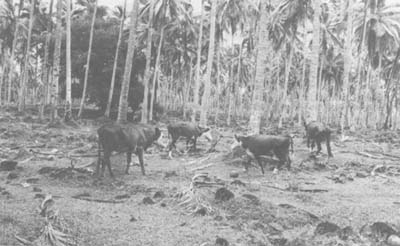
Figure 10. - Thin Hereford steers used as weed “sweepers” on local pasture under coconuts.
Coconut intercropping systems (and their advantages and disadvantages) and terminology have been mentioned by various authors (Akuba and Mahmud, 1991; Anon., 1975b; 1976a; 1976d; Bavappa, 1990a; 1990b; 1990c; Burgess, 1981; Chen, 1993; Cuevas, 1973; Danh, 1990; Darwis, 1990; Das, 1990; 1991; Empig, 1975; Fordham, 1983; Guzman, 1990; Ishak Jaafar, 1978; Karunanayake, 1990ba; 1990b; Klodpeng, 1990; Liyanage, 1983; 1990a; 1990b; Liyanage et al., 1984; 1986; 1989; Liyanage and Dassanayake, 1988; Magat, 1990; Mahmud and Akuba, 1989; Mangabat and Marquez, 1972: Mohd. Mahyuddin et al. (1978); Moog, 1993; Nair and Gopalasundaram, 1990; Ohler, 1974; Ontolan, 1988; Opio, 1990a; 1990b; 1990c; Plucknett, 1979; Ramos, 1976; Ranatunga et al., 1988; Reynolds, 1978e; Rosario, 1990; Rungrueng, 1988; Sahasranaman et al., 1983; Santhirasegaram, 1967b; Shelton and Stur, 1991; Stur and Shelton, 1991; Vandermeer, 1989; Wilson, 1994):
| Monoculture (or monocropping) | - | the cultivation of a single species of crop (coconut). |
| Multiple cropping | - | a general term for the growing of two or more crops on the same area of land in the same year. |
| Sequential cropping | - | (the time dependent form of multiple cropping) growing two or more crops in sequence on the same area of land in the same year. i.e. there is no intercrop competition and farmers manage only one crop at a time on the same area of land. |
| Intercropping | - | (the space dependent form of multiple cropping) growing two or more crops simultaneously on the same area of land in the same year. i.e. there is intercrop competition and farmers manage more than one crop at a time on the same area of land (e.g. pastures under coconuts, cacao under coconuts, vegetables under coconuts, etc.) (Vandermeer (1988) distinguishes between four subcategories i.e. mixed intercropping, row intercropping, strip intercropping and relay intercropping. Also some definitions indicate that the intercrops (under coconuts) are annual and seasonal crops and that the term mixed cropping should be used where perennial crops such as coffee or cacao or fruit trees are grown under coconuts). |
| Cropping system | - | the cropping patterns on a farm and their interaction with farm resources, other farm enterprises and available technology. |
| Multicropping | - | a planned system of intercropping where coconut spacing is modified to take into account the demands of the other crops. |
| Mixed farming | - | when animals of any kind are included in the farming system (e.g. cattle grazing pastures under coconuts). |
| Integrated farming | - | a farm practice which concurrently utilises the same unit area of land for the production of animals and crops. |
| Multistorey cropping | - | where a combination of different annual and perennial crops is established (between coconuts) so that their canopies exploit different air layers not used by the coconut e.g. clove and guava, pepper, banana, papaya, taro and pineapple (Bavappa et al., 1986; Nelliat et al., 1974). |
| Coconut-based farming systems (CBFS) | - | the integration of complementary enterprises in coconut farming (e.g. intercropping, livestock integration, processing of coconut products (by-products and intercrops and marketing) to increase productivity per unit area, increase employment opportunities and provide a buffer against low and fluctuating copra prices (Aguilar and Benard, 1991). |
Beets (1982) classifies into two broad groups the main reasons for adopting multiple cropping systems:
| - | Physio-technical reasons | (better utilization of environmental factors; (greater yield stability in variable environments; soil protection. |
| - | Socio-economic reasons | (magnitude of inputs and outputs (regularity of food supply. |
Das (1990), Jodha (1980), Lavaka (1988), Liyanage and Dassanayake (1988), Nair (1979), Nelliat and Krishna (1976), Ontolan (1988), Opio (1990a, 1990b), Plucknett (1979), Sefania et al. (1982), Shelton and Stur (1991), Stur and Shelton (1991) and others have detailed the relative advantages and disadvantages of intercropping coconuts.
Advantages:
Increased and diversified farm income (Darwis, 1988; Das, 1990; Denamany et al., 1979; Liyanage and Dassanayake, 1988; Ontolan, 1988; Opio, 1990b; Parawan, 1991; Rika, 1991; Shelton and Stur, 1991; Wahab, 1994).
Increased yields and increased food production (Parawan, 1991; Rika, 1991; Snaydon and Harris, 1981).
Increased stability for coconut farms through diversification and reduced dependence upon products with unstable market prices such as, copra, coconut oil, coir and others (Arganosa, 1991; Rika, 1991).
Care and attention given to management of intercrop tillage, weed control, use of fertilizers, among others, may lead to improved growth and yields of coconut palms and ease in finding the fallen nuts (Fernando et al., 1984). Coconut yields may receive more of a boost resulting from clearing undergrowth from existing areas than by planting large areas of new trees (Darwis, 1988; Reynolds, 1980; Rika, 1991; Shelton and Stur, 1991). According to Burgess (1981) at least 10% of copra was lost before harvest in Western Samoa due to nuts covered by weeds and missed in collection.
As management of the ground under coconuts is necessary, income-producing crops are preferable to weeds.
Reduced use of weedicides (Mahadevan and Devendra, 1986; Rika, 1991; Tajuddin and Chong, 1991).
Young palms require six or seven years to produce economic yields. Using catch crops, intercropped between the young coconuts, for food or sale (see Figure 8), may help to offset the cost of coconut establishment (Fordham, 1983) and reduce the time to full bearing through improved palm growth. Petmak (1991) noted that intercropping fast-growing tree species (Acacia auriculiformis, Leucaena leucocephala, etc.) with agricultural crops considerably benefitted tree growth in the first three years with wood production increased on average by 325% compared to control plots.
There may be better utilization of underemployed labour throughout the year and the coconut farmer's skill level may be raised (Darwis, 1988; Denamany et al., 1979; Ontolan, 1988; Parawan, 1991).
Possible reduction of the effect of natural calamities such as hurricanes, pests and diseases on total production since these do not usually affect all kinds of crops to the same extent or at the same time (Berges et al., 1993; Moog et al., 1993).
Helpful in conserving foreign exchange by supplying the domestic market with essential food products thus reducing the need to import (Ontolan, 1988).
Using legumes as intercrops may lead to increased soil fertility while cattle fertilize (with manure and urine) the soil (Cheva-Isarakul, 1991; Child, 1955; Devendra, 1987; Levaka, 1988; Mahadevan and Devendra, 1986; McPaul, 1964; Nugari, 1984; Ontolan, 1988; Rika, 1986, 1991; Wahab, 1994).
Better use of scarce land resources (Ontolan, 1988; Shelton and Stur, 1991). In many areas coconuts grow on land of good quality located close to settlements. Expensive land clearance schemes are used for poor quality highland areas instead of maximizing production on the better-quality lands by using limited inputs for intercropping. The use of poor quality land is costly and yield levels are low (Reynolds, 1977b). In Vanuatu, the conversion of native carpet and T-grass pasture (under coconuts and in the open) completely infested with Lantana camara or Solanum torvum producing 0–100 kg liveweight gain ha-1 yr-1, to improved pastures producing 450–700 kg liveweight gain ha-1 yr-1, depending on the environment, for 15,000–25,000 VT ha-1 (US$ 125–208.3 ha-1) (120 VT ≡1 US$, April 1993) is regarded as a superior investment compared to clearing and developing bush areas into pasture for a minimum cost of 50,000 VT ha-1 (US$ 416.7 ha-1). Pasture rehabilitation investment frequently produces internal rates of return of 30% whereas new improved pastures from recently cleared bush produce returns of only 8–9% (MacFarlane, 1993).
Coconuts may provide a better grazing environment for cattle than open areas (Frazer, 1974). In the Philippines the temperature under coconut shade is approximately 4–6°C lower than in open areas (Guzman and Allo, 1975; Sajise, 1973). Goldson (1973) reporting on dairy production in a cashew-pasture combination in coastal Kenya stressed the importance of tree shade for the animals, but found no difference in milk yields with and without shade. Robinson (1983) suggested that the effects of heat stress reduction by shade trees on animal production are numerous, the extent depending on the animal breed and the climate. He postulated that: animals eat and graze longer; need less water; feed conversion efficiency is improved; growth rate, milk yields and wool production are improved; reproduction rates should be improved and offspring survival rate will be higher. In Tanzania, Macfarlane and Stevens (1972) demonstrated that coconut shade had a very significant effect on Friesian crosses (increasing milk yield by 18.4 percent) but no significant effect on Borans. Temperature differences between shade and open areas varied from 1.5 to 9.5°C depending on the season. The effects of heat stress on dairy cattle have been assessed by Lemerle and Goddard (1986), McDowell (1972) and Richards (1985). In Australia, Davison et al. (1988) demonstrated that the provision of shade increased milk yield; Daly (1984) has stressed the importance of shade trees in beef production and Roberts (1984) showed that ewes in a shaded paddock produced significantly more lambs than those in an unshaded paddock (see Figure 11). However, in Thailand Hongyantarachai et al. (1989) demonstrated that although cattle kept indoors in a shaded cow shed during the day had rectal temperatures consistently 1–2°C lower than those of cattle kept outdoors, milk yields (averaging 14 kg cow-1 day-1) were no different and in fact milk fat percentage was higher and mastitis lower in cattle grazed outdoors for 24 hours. In the United States, shade in the corral confinement system was shown to have positive effects upon high-producing dairy cows (Schultz, 1983). In Paraguay, Evans and Rombold (1984) recommended planting trees (Melia azedarach var. “Gigante”) to reduce heat stress on grazing cattle. In Malaysia, Dollah and Sulaiman (1989) indicated that better reproductive performance in sheep was likely to result from shade and shearing (reduction of heat stress). Khusahry et al. (1993) noted that ewe performance from sheep under oil palm was superior to that under rubber and open pasture environments.
Coconut canopies may result not only in lower air temperatures (beneath the canopy) but also in lower soil temperatures which may be important for better seedling survival, soil water relations and possibly rate of litter breakdown and nitrogen mineralization. Also, air relative humidity will be higher and soil water availability for intercrops will be maintained at a higher level than in the open because of less evaporation from the soil and lower crop transpiration rates (Wilson and Ludlow, 1991; Wilson and Wild, 1991).
Many by-products from tree crop processing are readily available and potentially valuable for ruminant feeding and strategic supplementation. (Devendra, 1993).
Disadvantages:
Competition between intercrops and coconut, for water or plant nutrients (Santhirasegaram, 1966c; Stur and Shelton, 1991).
Intercrops may be uneconomical (losses to farmer) when planted where light is insufficient because coconut trees are too close together.
Intercrops may harbour diseases or attract pests harmful to coconuts.
Raising more than one crop on the same land area could increase the need for fertilizer, which may not be available (Beets, 1990).
Initially, as palms are shallow-rooted, tillage and cultivation operations required for intercrops may cause root damage to the main crop reducing yields.
The growth habit of some intercrops may cause difficulty in certain coconut management operations (e.g. fertilizer application, harvesting).
Where grazed pasture is the intercrop, cattle can damage palms or cause soil compaction. This disadvantage should be compared with possible soil erosion and declining soil fertility where other intercrops are used.
Intercropping may demand a higher level of skill from the farmer.
Grazing cattle under coconuts also requires the farmer to learn additional techniques associated with animal husbandry and pasture management (Mack, 1991; UNESCO, 1979). Lack of such skills may lead to failure (Shelton, 1991; Shelton et al., 1986). Invasion of unpalatable weeds can compete for moisture and nutrients, hinder nut collection and make the cattle-coconut system unviable (Rika, 1991).
While technically feasible the integration of ruminants with tree crops may not be socially acceptable (Chen, 1989; Ontolan, 1988; Shelton, 1991), or may require labour resources which the farmer wishes to use elsewhere (Beets, 1990; King, 1984), or require initial capital investment which the farmer cannot afford (Jayawardana, 1988).
Cattle dung may serve as a breeding place for rhinoceros beetle (Oryctes rhinoceros), a major insect pest of coconut (Anon, 1982).
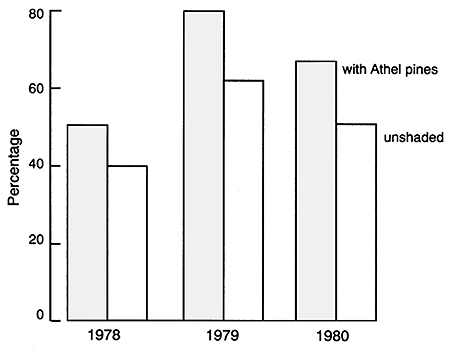
Figure 11. - Lamb-marking percentage of ewes lambing in a paddock planted with Athel pines and in an unshaded paddock (Roberts, 1984).
Constraints
Implementation and adoption of intercropping, mixed or integrated farming systems by smallholders will have various constraints. Persley (1992) lists important constraints faced by farmers when intercropping in Sri Lanka (from Liyanage et al., 1989). Constraints can be grouped into three categories (Mohd. Mahyuddin, 1978):
It is hoped that this book will provide information on the technical feasibility and economic viability of integrating cattle-pastures-coconuts; the decision on the social acceptability will have to be taken by the individual farmer, but it is hoped that sufficient information can be provided in the various chapters to identify the best potential system for each situation.
Although it can be argued that first priority should be given to food crops and second priority to raising livestock, there are at least two situations, with intermediate events, which justify the integration of livestock and coconuts (Reynolds, 1980):
Where population densities are high and available land areas are small priority must be given to food growing and cash crops. Cattle can be introduced (possibly already present as draught animals) utilizing various crop by-products. Forages are cut and hand carried to tethered or stall-fed animals. This system is traditionally widespread in South East Asia. Work in Malaysia, Mauritius and Seychelles using banana, copra cake, cocoa pods, coffee by-products, sugar cane, sweet potato vines and Leucaena leucocephala suggests that intensive beef and milk production are possible by small-holders on farms of 2–4 hectares where food and cash crops are integrated with livestock. Manure is utilized for biogas production before being recycled for land use (Abdullah Sani Ramli et al., 1982; Preston and Leng, 1978b; Preston 1979a).
Where land limitation is not critical and extensive inter-cropping is possible, the choice may range from cocoa, coffee, cloves and citrus to the grazing of cattle on local or improved pastures.
The choice of intercrop depends on many factors such as soil, nature of the coconut stand (age, spacing, variety), rainfall, type and size of production system, market proximity and personal preference.
Many factors govern the level of animal production (see Figure 12). However good pastures and high quality feedstuffs alone do not guarantee a high level of animal output. It is the level of a number of factors which determines production. If any of these is limited, for example a deficiency of phosphorus or nitrogen (within the soil system), then pasture production will be influenced. When drinking water is not available to cattle (see Table 6), or there are disease problems (tsetse or tickborne) animal production levels will be affected even though all other factors are at optimum levels. A simple model showing many factors affecting digestibility and herbage intake by grazing animals is shown in Figure 13.
People keep cattle for different reasons (Baker, 1981; Payne, 1976; Ruthenberg, 1980; Shelton, 1991; Spedding, 1979; Williams, 1976). The commercial cattle producer profits from selling meat, milk or the animal. In many tropical areas where crop farming is the main occupation, cattle serve as draught animals. The meat or milk production is regarded as a bonus and may be either sold or used by the producer. In traditional pastoralist societies, production of milk, meat, blood and hides is important but the number of animals owned is often more important than the level of performance, condition of the herd, or profit obtained, because the size of herd may determine the social status of the individual or family. In some societies, the animal is considered not so much for cash or products, but more as a walking bank deposit to be used at times of crisis or celebration, when resources are urgently needed.
Table 6. - Liveweight gains on good local pastures with and without access to drinking water (Reynolds, 1977e)
| Liveweight gains (kg-1 ha) | |||
| Period | Rainfall (mm) | Forage + water | Forage - water* |
| 1 | 128.0 | 10.0 | 22.9 |
| 2 | 33.8 | 26.9 | -46.4 |
| 3 | 73.0 | -13.1 | 3.8 |
| 4 | 43.2 | 22.2 | -15.3 |
| 5 | 2.1 | 6.7 | -70.6 |
| Total Gains | 52.7 | -105.6 | |
* Cattle obtained water only from eating forage.
It is important to determine the reasons for keeping cattle and the type of production system because this will influence the type and scale of operation. Methods used by small-holders may be labour intensive whereas mechanized extensive systems may be used on large holdings and plantation size units.
World population and the high rates of increase, especially in developing countries (see Table 7), require an increase in food production, including animal protein (see Table 8) to feed the growing numbers. Walker and Rotar (1983) demonstrated a close relationship between animal protein consumption and the physical quality of life in tropical countries (see Figure 14). Although the problem of additional food can be partially resolved by increasing the use of marginal lands, another solution, as noted in Section 1.1., is to utilize the large area of tree crops in the humid tropics for intercropping. As the area of tree crops coincides with areas of rapid population increase (see Table 9) and the areas where large numbers of the rural population are below the poverty line (see Table 10), the exploitation of intercropping potential becomes a matter of some priority. The human population of South East Asia increased by more than 100 percent during the period 1961/65 to 1991 while increases in livestock numbers were far below this rate. Sarma and Yeung (1975) suggest that if trends in meat consumption and production since 1960 in East and Southeast Asia continue to the year 2000, then the region's level of self-sufficiency in meat production could decline from 94 percent in 1973–77 to 74 percent in 1990 and only 62 percent in the year 2000 (see Table 11).
Table 7. - Comparison of world population trends and prospects in the more and less developed regions 1980–2000.
| World | More developed Regions | Less Developed Regions | ||||
| A* | B* * | A | B | A | B | |
| 1980 | 4415 | 1.81 | 1131 | 0.67 | 3284 | 2.21 |
| 1985 | 4830 | 1.80 | 1169 | 0.67 | 3661 | 2.17 |
| 1990 | 5276 | 1.76 | 1206 | 0.62 | 4070 | 2.12 |
| 1995 | 5734 | 1.67 | 1240 | 0.56 | 4494 | 1.98 |
| 2000 | 6199 | 1.56 | 1273 | 0.51 | 4926 | 1.84 |
A * = population (millions)
B * * = rate of increase (percent)
Source (UN, 1980)
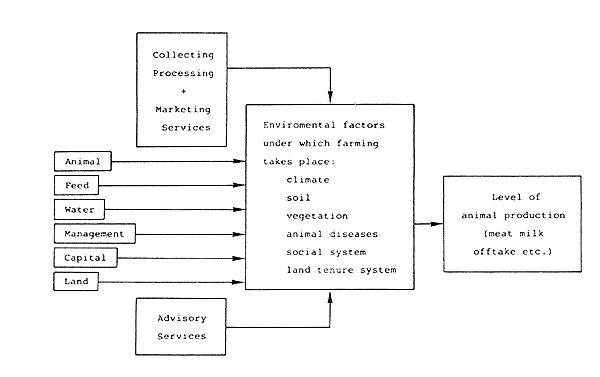
Figure 12. - Some factors influencing level of animal production.

Figure 13.- Factors affecting the digestibility and herbage intake by grazing animals (Reid and Jung, 1982).
Table 8.- Production of animal protein in the world in 1977 (kg)
| Region | Per capita | Per person active in agriculture | Per animal unit | Per ha agr. land |
| Developed | 22 | 50 | 45 | 13 |
| Developing | 3 | 9 | 8 | 3 |
| World | 8 | 21 | 22 | 8 |
Source: (Fitzhugh and de Boer, 1981)
Table 9.- Human and animal population in Southeast Asia, world total %
| Number (,000) | % Change | % World Total | Livestock per human (no.) | ||
| 1961/65 | 1991 | ||||
| Humans | 223,705 | 453,462 | 102.7 | 8.4 | |
| Cattle | 21,279 | 34,344 | 61.4 | 2.7 | 0.08 |
| Sheep | 3,732 | 6,438 | 72.5 | 0.5 | 0.01 |
| Goats | 8,990 | 15,498 | 72.4 | 2.6 | 0.03 |
| Buffalo | 17,802 | 18,012 | 1.2 | 12.7 | 0.04 |
| Horses, mules, asses | 1,194 | 1,311 | 6.1 | 1.1 | 0.003 |
Source: FAO Production Yearbook, 1991.
Table 10.- Rural population below the poverty line in 114 developing countries 1988 (after Jazairy, 1992)
| Region | Population | Rural Population as percent of total population | Rural population below poverty line | ||
| Total | Rural | As percent of | |||
| Asia | 2,713 | 2,019 | 74 | 633 | 31 |
| Asia (excluding China and India) | 812 | 567 | 70 | 262 | 46 |
| Sub-Saharan Africa | 462 | 337 | 73 | 204 | 60 |
| Near East and North Africa | 208 | 106 | 51 | 27 | 26 |
| Latin America and the Caribbean | 425 | 123 | 29 | 76 | 61 |
| Total 114 developing countries | 3,809 | 2,584 | 68 | 939 | 36 |
| Least developed countries | 461 | 368 | 80 | 253 | 69 |
(Percentage of rural population below the poverty line in 1988 in the main coconut producing countries: Philippines 64%; Indonesia 27%; India 42%; Sri Lanka 46%; Malaysia 22%; Thailand 34%).
Table 11.- Projected meat consumption and production trends in East and Southeast Asia1 (after Sarma and Yeung, 1975; Remenyi and McWilliam, 1986).
| Actual | Projections | |||
| 1961–1965 | 1973-1977 | 1990 | 2000 | |
| (Million tonnes) | ||||
| Meat consumption | 2.2 | 3.4 | 7.3 | 12.8 |
| Meat production2 | 2.1 | 3.2 | 5.4 | 7.9 |
| Balance | -0.1 | -0.2 | -1.9 | -4.9 |
1 Includes ASEAN, Fiji, Hong Kong, Cambodia, North and South Korea, Laos, Mongolia, Myanmar, Papua New Guinea and Vietnam.
2 Ruminant meats represented 55% in 1961–65 and 51% in 1973–77.
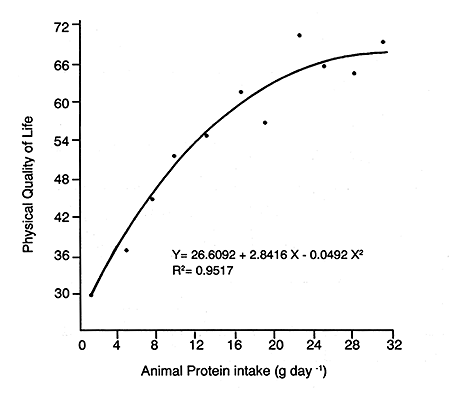
Figure 14.- Relationship between animal protein intake and life quality in 95 developing countries in the tropics (Walker and Rotar, 1983).